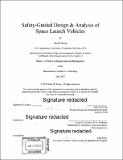| dc.contributor.advisor | Nancy G. Leveson. | en_US |
| dc.contributor.author | Rising, John M. (John Michael) | en_US |
| dc.contributor.other | Massachusetts Institute of Technology. Integrated Design and Management Program. | en_US |
| dc.date.accessioned | 2018-10-15T20:23:46Z | |
| dc.date.available | 2018-10-15T20:23:46Z | |
| dc.date.copyright | 2018 | en_US |
| dc.date.issued | 2018 | en_US |
| dc.identifier.uri | http://hdl.handle.net/1721.1/118525 | |
| dc.description | Thesis: S.M. in Engineering and Management, Massachusetts Institute of Technology, System Design and Management Program, 2018. | en_US |
| dc.description | Cataloged from PDF version of thesis. | en_US |
| dc.description | Includes bibliographical references (pages 103-108). | en_US |
| dc.description.abstract | The advent of commercial launch systems has brought about a new age of space launch vehicle design. In order to survive in a competitive market, space launch providers must design systems with new technologies in shorter development times. This changing nature of space launch vehicle design requires a new way to perform safety analysis. Traditional hazard analysis techniques do not deliver adequate insight early in the design process, when most of the safety-related decisions are made. Early design decisions are often made using "lessons-learned" from previous launch systems, rather than interactive feedback from the new vehicle design actually being developed. Furthermore, traditional techniques use reliability theory as their foundation, resulting in the use of excessive design margin and redundancy as the "default" vehicle design choices. This equivocation of safety and reliability may have made sense for simpler launch vehicles of the past, but most modern space launch vehicle accidents have resulted from incorrect software specifications, component interaction accidents, and other design errors independent of the reliability of individual components. The space launch industry needs safety analysis methods and design processes that identify and correct these hazards early in the vehicle design process, when modifications to correct safety issues are more effective and less costly. This work shows how Systems-Theoretic Process Analysis (STPA) can been used as a powerful tool to identify, mitigate, and possibly eliminate hazards throughout the entire space launch vehicle lifecycle. This work begins by reviewing traditional hazard analysis techniques and the changing nature of launch vehicle accidents. Next, it describes how STPA can be integrated into the space launch vehicle lifecycle to design safer systems. It then demonstrates the safety-guided design of a small-lift launch vehicle using STPA. Finally, this work shows how STPA can be used to satisfy regulatory and range safety requirements. The thesis of this work is that integration of STPA into the design of space launch vehicles can make a significant contribution to reducing launch vehicle accidents. | en_US |
| dc.description.statementofresponsibility | by John M. Rising. | en_US |
| dc.format.extent | 132 pages | en_US |
| dc.language.iso | eng | en_US |
| dc.publisher | Massachusetts Institute of Technology | en_US |
| dc.rights | MIT theses are protected by copyright. They may be viewed, downloaded, or printed from this source but further reproduction or distribution in any format is prohibited without written permission. | en_US |
| dc.rights.uri | http://dspace.mit.edu/handle/1721.1/7582 | en_US |
| dc.subject | Engineering and Management Program. | en_US |
| dc.subject | Integrated Design and Management Program. | en_US |
| dc.title | Safety-guided design & analysis of space launch vehicles | en_US |
| dc.title.alternative | Safety-guided design and analysis of space launch vehicles | en_US |
| dc.type | Thesis | en_US |
| dc.description.degree | S.M. in Engineering and Management | en_US |
| dc.contributor.department | Massachusetts Institute of Technology. Engineering and Management Program | en_US |
| dc.contributor.department | Massachusetts Institute of Technology. Integrated Design and Management Program. | en_US |
| dc.identifier.oclc | 1054911354 | en_US |
